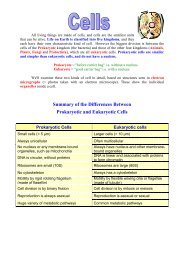HEART – STRUCTURE - BiologyMad A-Level Biology
HEART – STRUCTURE - BiologyMad A-Level Biology
HEART – STRUCTURE - BiologyMad A-Level Biology
You also want an ePaper? Increase the reach of your titles
YUMPU automatically turns print PDFs into web optimized ePapers that Google loves.
• 4 sections<br />
Left atrium<br />
Right atrium<br />
Left ventricle<br />
Right ventricle<br />
•<br />
4 main blood routes<br />
into and out of the<br />
heart<br />
Vena Cava<br />
Pulmonary<br />
artery<br />
Aorta<br />
Pulmonary vein<br />
<strong>HEART</strong> <strong>–</strong> <strong>STRUCTURE</strong><br />
Right Atrium<br />
Vena Cava<br />
Tricuspid valves<br />
Right Ventricle<br />
Aorta Pulmonary artery<br />
Left Atrium<br />
Semi-lunar valves<br />
Left side of the heart has more muscle than the right side because the blood<br />
from the right hand side just has to go to the lungs WHEREAS<br />
the blood from<br />
the<br />
left hand side has to be pumped all around the body.<br />
Bicuspid valves<br />
• 2 lot’s of valves <strong>–</strong> there are each set on valves on both sides of the heart<br />
Atrioventricular valves <strong>–</strong> between the atrium and the ventricles<br />
Tricuspid valve on the right<br />
Bicuspid (mitral) valve on the left<br />
Semi-lunar valves <strong>–</strong> in the pulmonary artery and the aorta<br />
Pulmonary vein<br />
Left Ventricle
CARDIAC CYCLE<br />
Deoxygenated blood enters from the body<br />
into the right atrium via the Vena Cava<br />
Once all the blood has entered into the<br />
right atrium the blood is pushed down into<br />
the right ventricle<br />
The blood is then pumped up through the<br />
Pulmonary artery to the lungs where<br />
gaseous exchange occurs ( CO2<br />
diffuses out of the blood and O2 is diffuses<br />
in from the lungs<br />
The newly oxygenated blood is returned to<br />
the heart via the Pulmonary Artery into<br />
the left atrium<br />
The blood is pumped down into the left<br />
Ventricle<br />
The blood is pumped from the left ventricle<br />
up through the Aorta and is pumped around<br />
the body to provide oxygen to organs<br />
Vena Cava<br />
Right Atrium<br />
Right Ventricle<br />
Pulmonary Artery<br />
Left Atrium<br />
Left Ventricle<br />
Aorta
Miss G’s input (I hope you don’t mind Claire and Matilda)<br />
Pressure changes in the heart and how the valves open and close<br />
The only way blood moves from the atrium and into the ventricles, is due to<br />
pressure changes. When the atriums are relaxed and at diastole, they<br />
fill with blood causing the pressure to increase. The atrium will<br />
sino-atrial node (SAN)<br />
then receive impulses (from the SA node) to contract (systole) and<br />
atrio-ventricular node (AVN)<br />
the pressure increases even more, and is higher than the pressure<br />
in the ventricles, causing the atrioventricular valves (AV valves) to<br />
Bundle of His<br />
open, forcing blood to enter the ventricles. As blood fills the<br />
Purkinje fibres<br />
ventricles, the pressure increases, and become higher in the ventricles<br />
than in the atrium. This causes the AV valves to close. At this same time,<br />
the AV node (stimulated by the impulses across the top two atria) will send impulses over the ventricles (bundle<br />
of His and purkinji fibres), causing the ventricles to contract. Whilst the ventricles have contracted, the<br />
atriums have been relaxed and have filled with blood. Once the ventricles have contracted, both the atrium<br />
and ventricles will relax and be at diastole, and will wait for another impulse to reach the SA node.<br />
The noise of the heart beat (‘lub dub’), is only due the AV valves opening and closing. The ‘lub’ noise is due the<br />
AV valves opening and the ‘dub’ occurs when the valves close<br />
Name<br />
Events<br />
Pressure (kPa)<br />
PCG<br />
ECG<br />
15<br />
10<br />
Time (s)<br />
5<br />
0<br />
Atrial Systole<br />
atria contract<br />
blood enters ventricles<br />
atrium<br />
ventrical<br />
Ventricular Systole<br />
ventricles contract<br />
blood enters arteries<br />
Diastole<br />
atria and ventricals both relax<br />
blood enters atria and ventricles<br />
semilunar<br />
semilunar<br />
valves open<br />
valves close<br />
0 0.1 0.2 0.3 0.4 0.5 0.6 0.7 0.8<br />
20<br />
arteryartery<br />
atrioventricular<br />
valves close<br />
atrioventricular<br />
valves open<br />
atrium<br />
ventrical<br />
0 0.1 0.2 0.3 0.4 0.5 0.6 0.7 0.8
















